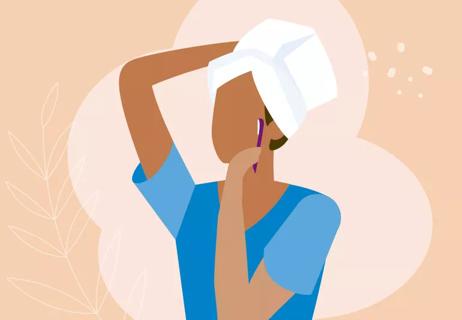Do a test area first to see how your skin reacts

You’ve started to notice some fine lines and wrinkles on your face (ugh!) or maybe your skin looks a little lackluster (blah!).
Advertisement
Cleveland Clinic is a non-profit academic medical center. Advertising on our site helps support our mission. We do not endorse non-Cleveland Clinic products or services. Policy
And in your quest to reduce fine lines and wrinkles, improve your skin’s brightness, and diminish discoloration and brown spots, you may have thought about trying a chemical peel at home.
Previously, you could only get a chemical peel as an in-office treatment at your doctor’s office. Now, there are plenty of at-home chemical peels available, making it tempting to want to give this skin care approach a spin.
But before you get started, dermatologist Shilpi Khetarpal, MD, walks us through how a chemical peel works and how to choose the best version for you.
A chemical peel is a chemical solution that’s used to improve the appearance of your skin. When applied to the top layer of your skin, the solution causes that skin to eventually peel off, unveiling a new layer of more youthful skin underneath.
“A chemical peel is basically a way to exfoliate your skin,” explains Dr. Khetarpal. “You can use a chemical peel to target concerns like acne, hyperpigmentation, fine lines or texture. You’re helping your skin cells turnover.”
So, how does a chemical peel feel when it’s on your face?
“It will tingle and it may burn a bit and feel hot,” says Dr. Khetarpal. “It’s mildly uncomfortable, but you definitely will know it’s doing something to your skin.”
Advertisement
And with most chemical peels, there is some downtime. Depending on the strength of the chemical peel, you may experience redness, peeling, flaking and sensitivity — similar to a sunburn — for up to two weeks after.
You may opt to visit a dermatologist for a chemical peel. By doing so, you’ll tend to get a higher concentration of ingredients like glycolic acid, lactic acid or salicylic acid.
Another bonus? You’re also getting the treatment applied by an expert who can make sure to target your skin concerns (like wrinkles or discoloration) with the right kind of chemical peel.
But if you want to explore the world of chemical peels in the comfort of your own home, Dr. Khetarpal says there are many versions available.
Whether the chemical peel is delivered via peel pads, a liquid application or a product that you wash off, at-home treatments tend to be gentler on your skin.
And due to the lower concentration of ingredients, you may need to apply a few treatments before you see any results like smoother skin or faded dark spots.
Doing a chemical peel at home does require some homework beforehand. You want to avoid tanning or being in the sun for about two weeks before using a chemical peel. Remember: Sunscreen is your best friend.
You also want to consider what type of skin care ingredients you’re using in the lead up to a chemical peel.
“If you’ve been using a vitamin A cream like a retinol, tretinoin or adapalene, it thins the top layer of your skin,” cautions Dr. Khetarpal. “The chemical peel will go a little bit deeper, so you’re going to get more of an effect.”
Another important task before doing a chemical peel at home?
“Do a test area first,” stresses Dr. Khetarpal. “Apply a small amount to your jawline or behind your ear. Give it a day and see how your skin reacts. And you want to do this especially if you have sensitive skin, dry skin or eczema, just to make sure you don’t end up with inflammation or a reaction to something in the product.”
Dr. Khetarpal offers some other tips:
Advertisement
Some peels are self-neutralizing and can be left on your skin. But others need to be washed off or neutralized with a separate solution. It’s important to read all the directions and make sure you have all the necessary components before you start a chemical peel.
“There are a lot of different options out there,” Dr. Khetarpal notes. “A chemical peel can be tailored to your needs depending on your skin type and concern.”
First, let’s learn about the different types of chemical peels:
Advertisement
When it comes to ingredients, chemical peels typically include:
If you take birth control pills, are pregnant or have a family history of discoloration, you may have an increased risk of developing abnormal pigmentation.
“If you’re someone that has a history of cold sores, a chemical appeal can trigger an outbreak,” states Dr. Khetarpal.
How your skin responds to a chemical peel will depend on the strength and type of chemical peel you use. You may experience a sunburn-like reaction, which can include redness, flaking and peeling for up to a week.
During this time, you want to use a gentle cleanser to wash your face, followed by a moisturizer and sunscreen.
“You’ve just disrupted your skin’s barrier and you’re trying to restore it and help it heal,” explains Dr. Khetarpal. “Keep your skin moist by using a very gentle moisturizer. You want to baby your skin.”
Advertisement
There are a lot of upsides to exploring the world of at-home chemical peels. Just make sure to do your homework, consult a dermatologist and follow a product’s instructions to ensure the best outcome for your skin.
Learn more about our editorial process.
Advertisement

Shaving your face can actually give you smoother skin

Several conditions, like vitiligo and fungal infection, can cause a loss of pigmentation, leading to white spots or patches on your skin

Moisturizing, running a humidifier and adjusting your showers may help keep itchiness and irritation at bay

‘Zit stickers’ can help heal a new or popped pimple, but they’re limited when it comes to managing acne

Glycolic acid benefits skin tone, texture and pigmentation by exfoliating dead skin

At-home treatments and lifestyle changes may help ease the symptoms and improve the appearance of varicose veins — but they aren’t a cure

Scalp cancers can occur because of long-term sun exposure

Babies can get congested easily, but you can calm their cough by keeping them hydrated, using nasal drops and running a humidifier

Weight loss may cause loose, sagging skin and muscle loss to your rear

Several conditions, like vitiligo and fungal infection, can cause a loss of pigmentation, leading to white spots or patches on your skin